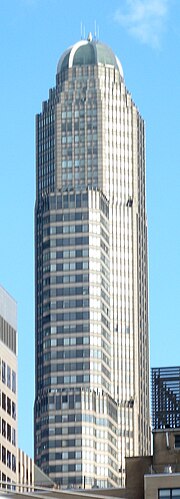
The Unisphere is a spherical stainless steel representation of the Earth in Flushing Meadows–Corona Park in the New York City borough of Queens. The globe was designed by Gilmore D. Clarke as part of his plan for the 1964 New York World's Fair. Commissioned to celebrate the beginning of the space age, the Unisphere was conceived and constructed as the theme symbol of the World's Fair. The theme of the World's Fair was "Peace Through Understanding", and the Unisphere represented the theme of global interdependence, being dedicated to "Man's Achievements on a Shrinking Globe in an Expanding Universe".

St. Patrick's Cathedral is a Catholic cathedral in the Midtown Manhattan neighborhood of New York City. It is the seat of the Archbishop of New York as well as a parish church. The cathedral occupies a city block bounded by Fifth Avenue, Madison Avenue, 50th Street, and 51st Street, directly across from Rockefeller Center. Designed by James Renwick Jr., it is the largest Gothic Revival Catholic cathedral in North America.

Deutsche Bank Center is a mixed-use building on Columbus Circle in Manhattan, New York City. The building occupies the western side of Columbus Circle and straddles the border between Hell's Kitchen and the Upper West Side. It was developed by The Related Companies and Apollo Global Management, and designed by David Childs and Mustafa Kemal Abadan of Skidmore, Owings & Merrill.

40 Wall Street, also known as the Trump Building, is a 927-foot-tall (283 m) neo-Gothic skyscraper on Wall Street between Nassau and William streets in the Financial District of Manhattan in New York City. Erected in 1929–1930 as the headquarters of the Manhattan Company, the building was formerly known as the Bank of Manhattan Trust Building and the Manhattan Company Building. 40 Wall Street was designed by H. Craig Severance with Yasuo Matsui and Shreve & Lamb. The building is a New York City designated landmark and is listed on the National Register of Historic Places (NRHP); it is also a contributing property to the Wall Street Historic District, an NRHP district.
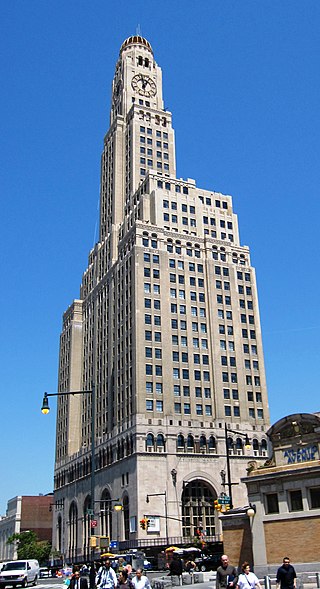
The Williamsburgh Savings Bank Tower, also known as One Hanson Place, is a skyscraper in the Fort Greene neighborhood of Brooklyn in New York City. Located at the northeast corner of Ashland Place and Hanson Place near Downtown Brooklyn, the tower was designed by Halsey, McCormack and Helmer and constructed from 1927 to 1929 as the new headquarters for the Williamsburgh Savings Bank. From the time of its construction until 2009, One Hanson Place was the tallest building in Brooklyn at 41 stories and 512 feet (156 m) tall.

The Bank of America Tower, also known as 1 Bryant Park, is a 55-story skyscraper in the Midtown Manhattan neighborhood of New York City. It is located at 1111 Avenue of the Americas between 42nd and 43rd Streets, diagonally opposite Bryant Park. The building was designed by Cookfox and Adamson Associates, and it was developed by the Durst Organization for Bank of America. With a height of 1,200 feet (370 m), the Bank of America Tower is the eighth tallest building in New York City and the tenth tallest building in the United States as of 2022.

Axa Equitable Center is an office skyscraper at 787 Seventh Avenue, between 51st and 52nd Streets, in the Midtown Manhattan neighborhood of New York City. Completed in 1986 and designed by Edward Larrabee Barnes, the building measures 752 feet (229 m) tall with 54 stories. Equitable Center West was developed by the Equitable Life Assurance Society adjacent to Equitable's existing skyscraper at 1285 Avenue of the Americas.

Metropolitan Tower is a mixed-use skyscraper at 146 West 57th Street in the Midtown Manhattan neighborhood of New York City. Completed in 1987 and designed by SLCE Architects, the building measures 716 ft (218 m) tall with 68 stories. Metropolitan Tower is designed with a black-glass facade, with a rectangular 18-story base topped by a 48-story triangular tower. It was developed by Harry Macklowe.

Carnegie Hall Tower is a skyscraper at 152 West 57th Street in the Midtown Manhattan neighborhood of New York City. Completed in 1990 and designed by César Pelli, the building measures 757 feet (231 m) tall with 60 stories. Due to the presence of Carnegie Hall and the Russian Tea Room on adjacent sites, the tower is only 50 feet (15 m) wide on 57th Street, making it among the world's most slender skyscrapers at its completion.

The New York Times Building is a 52-story skyscraper at 620 Eighth Avenue, between 40th and 41st Streets near Times Square, on the west side of Midtown Manhattan in New York City. Its chief tenant is the New York Times Company, publisher of The New York Times. The building is 1,046 ft (318.8 m) tall to its pinnacle, with a roof height of 748 ft (228 m). Designed by Renzo Piano and Fox & Fowle, the building was developed by the New York Times Company, Forest City Ratner, and ING Real Estate. The interiors are divided into separate ownership units, with the Times Company operating the lower office floors and Brookfield Properties operating the upper floors. As of 2023, the New York Times Building is tied with the Chrysler Building as the twelfth-tallest building in the city.

The David N. Dinkins Municipal Building is a 40-story, 580-foot (180 m) building at 1 Centre Street, east of Chambers Street, in the Civic Center neighborhood of Manhattan in New York City. The structure was built to accommodate increased governmental space demands after the 1898 consolidation of the city's five boroughs. Construction began in 1909 and continued through 1914 at a total cost of $12 million.

Central Park Place is a residential condominium building in the Hell's Kitchen and Midtown Manhattan neighborhoods of New York City. The building is at 301 West 57th Street, at the northwest corner with Eighth Avenue. Davis Brody Bond designed Central Park Place, which is 628 feet (191 m) tall with 56 stories. Central Park Place's facade is made of gray-green glass and aluminum panels, a color scheme intended to associate the building with the nearby Central Park.
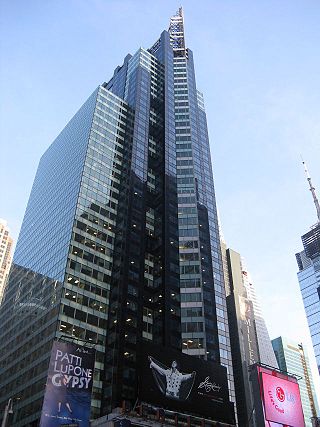
1540 Broadway, formerly the Bertelsmann Building, is a 44-story office building on Times Square in the Theater District neighborhood of Manhattan in New York City. Designed by David Childs of Skidmore, Owings & Merrill (SOM), the building was developed by Broadway State Partners, a joint venture between Bruce Eichner and VMS Development. 1540 Broadway occupies a site bounded by Broadway to the west, 45th Street to the south, and 46th Street to the north. It was originally named for its anchor tenant, German media company Bertelsmann. The building is divided into two ownership units: HSBC and Edge Funds Advisors own the office stories, while Vornado Realty Trust owns retail space at the base.

Times Square Tower, also known as 7 Times Square, is a 48-story office skyscraper at the southern end of Times Square in the Midtown Manhattan neighborhood of New York City. Located on the city block bounded by Broadway, 42nd Street, Seventh Avenue, and 41st Street, the building measures 724 feet (221 m) tall. The building was designed by David Childs of Skidmore, Owings & Merrill and developed by Boston Properties. The site is owned by the New York City Department of Citywide Administrative Services, though Boston Properties and Norges Bank have a long-term leasehold on the building.

750 Seventh Avenue is a 36-story office building in the Midtown Manhattan neighborhood of New York City. The building was designed by Kevin Roche of Roche-Dinkeloo and developed by David and Jean Solomon. 750 Seventh Avenue occupies a site on the north side of 49th Street between Broadway and Seventh Avenue. Since 1994, the building has mostly been occupied by the offices of financial services company Morgan Stanley. The building contains a black glass facade with large signs as well as etched-glass panels. On the upper stories, the exterior has setbacks in a spiral pattern, which terminate in an offset glass pinnacle. When the building opened, several critics compared its design to a smokestack and to a glass pyramid.

The Candler Building is a skyscraper at the southern end of Times Square in the Midtown Manhattan neighborhood of New York City. Located at 220 West 42nd Street, with an alternative address of 221 West 41st Street, the building contains 24 stories. The building was designed by the firm of Willauer, Shape and Bready in the Spanish Renaissance style. It was constructed between 1912 and 1913 for Coca-Cola Company owner Asa Griggs Candler. The Candler Building was one of the last skyscrapers built in New York City before the 1916 Zoning Resolution, which required setbacks. It is listed on the National Register of Historic Places (NRHP).
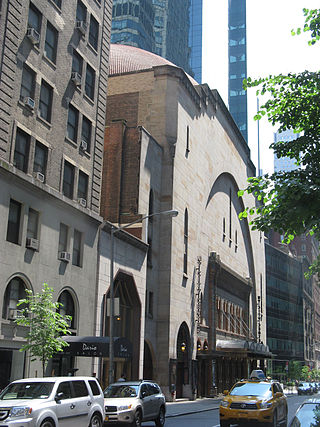
New York City Center is a performing arts center at 131 West 55th Street between Sixth and Seventh Avenues in the Midtown Manhattan neighborhood of New York City. Developed by the Shriners between 1922 and 1924 as a Masonic house of worship, it has operated as a performing arts complex owned by the government of New York City. City Center is a performing home for several major dance companies as well as the Manhattan Theatre Club (MTC), and it hosts the Encores! musical theater series and the Fall for Dance Festival annually.

3 Times Square, also known as the Thomson Reuters Building, is a 30-story skyscraper at Times Square in the Midtown Manhattan neighborhood of New York City. Located on Seventh Avenue between 42nd and 43rd Street, the building measures 555 feet (169 m) to its roof and 659 feet (201 m) to its spire. The building was designed by Fox & Fowle and developed by Rudin Management for news-media company Reuters. The site is owned by the New York City Economic Development Corporation, though Rudin and Reuters have a long-term leasehold on the building.

The Millennium Times Square New York is a hotel at 133 and 145 West 44th Street, between Times Square and Sixth Avenue, in the Theater District of Midtown Manhattan in New York City. Operated by Millennium & Copthorne Hotels, the hotel has 750 guest units, as well as a conference center with 33 conference rooms. The hotel incorporates a Broadway theater called the Hudson Theatre into its base.
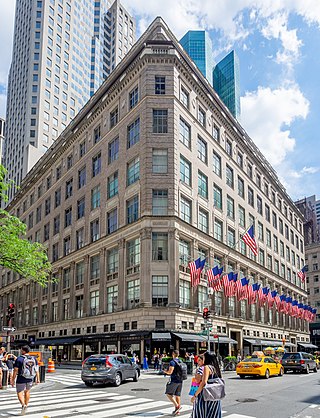
The Saks Fifth Avenue flagship store is a department store in Midtown Manhattan, New York City on Fifth Avenue between 49th and 50th Streets. The original 10-story structure at 611 Fifth Avenue has served as the flagship store of Saks Fifth Avenue since its completion in 1924. The store also occupies part of 623 Fifth Avenue, a 36-story tower completed in 1990.
